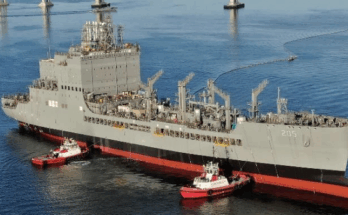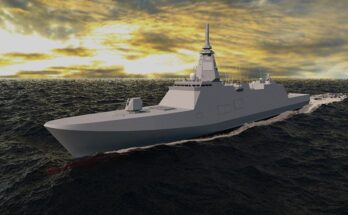by Stuart Slade, Warships Analyst, Forecast International.

The provision of additional funding for the 12th member of the LPD-17 class bears an uncanny similarity to the maneuvering that took place over the construction of the eighth ship in the LHD-1 Wasp class. In both cases, the U.S. Congress was insistent on funding the ships despite Navy objections and warnings that construction was unaffordable. In both cases, Congress saw the additional ships as being a valuable bridge to the next class in that category and a chance to evaluate technology options for the next generation of amphibious warfare ships. And in both cases, the Navy eventually agreed with the argument and the ships were ordered.
With the proposed acceleration of the LX(R) program, the immediate question will be how closely that design is related to the LPD-17. There have been numerous statements that the LX(R) will use the same hull as the LPD-17 and will be a reduced-cost version of the LPD-17 design. Current suggestions are that the LX(R) will differ from the LPD-17 by having increased aviation, command and control, and medical capabilities comparable to those of the LSD-41 class. These enhancements will give the LX(R) the ability to operate independently from the Amphibious Ready Groups (ARGs). In order to reduce costs, the LX(R) will have only two landing craft, air cushion (LCAC) spots and other unspecified modifications. Interestingly, advance illustrations of the LX(R) show the ship having conventional tripod masts in place of the sophisticated integrated masts deployed on the LPD-17. This may point to major simplifications of the electronics suite.
Nonetheless, the practicality of using the basic LPD-17 hull design must be questioned. The LPD is a personnel transport, intended to bring U.S. Marines to the scene of action and deliver them to the shore. The LSD is oriented toward the transport of heavy vehicles and supplies to support that landing force. Presumably, the LX(R) will perform that latter requirement. Such a task places grave demands on the structure of a ship, and a different approach to the details of hull design will be needed. The scope of change will require significant research, but a calculated estimate is that the cargo deck and its supports will require substantial strengthening. Other provisions may well be necessary to prevent cracking and other forms of stress-induced hull failure.
This research and development effort may be the key in deciding the final timing for the construction of the LX(R) class. The original plan was to start building the first-of-class in 2020, with the rest spaced out over a 10-year period ending in 2031. The problem with this is that it would add to the funding famine that will strike when SSBN(X) construction starts. The latest congressional proposal is for LX(R) construction to start in 2017. This would eliminate the gap between the LPD-17 and the LX(R), and would likely bring substantial infrastructure-support cost savings as a result. The problem is that this would leave inadequate time for the required research and development. A compromise of starting construction of the first ship in 2018, for commissioning in 2021, with an accelerated schedule thereafter seems ideal, and it may be significant that this proposal is gaining traction.
The question then becomes, what effect will the funding of the 12th LPD-17 have on the production run for the LX(R)?
Normally, LPDs and LSDs are built in equal numbers, a policy reflected by the original plan to build 11 LPD-17s and 11 LX(R)s. However, the force level for the amphibious fleet was set at 33 ships: 11 LHAs/LHDs, 11 LPD-17s, and 11 LX(R)s. It was recognized that the ideal number of ships would be 38, but a calculated risk was taken to accept 33 in order to save money. Now, with the addition of a 12th LPD-17, the apparent build total for the amphibious fleet will increase to 34.
The obvious way to comply with the existing force level is to reduce the LX(R) build by one ship, bringing the fleet back to the authorized total of 33. Yet, this would result in an unbalanced total of 12 LPD-17s and 10 LX(R)s. A good case can be made that an extra LX(R) could be ordered that would bring the class to 12 ships, balancing the totals and increasing the amphibious fleet to 35 ships. This would reduce the level of calculated risk accepted for the 33-ship fleet by a comforting amount. This could even be extended further by adding an additional LHA, resulting in a 36-ship amphibious fleet with 12, rather than 11, ARGs. A force structure of this nature would not only be in line with the ideal discussed by the Navy, but would also make additional construction funding essential.
FI’s Naval Systems Market Intelligence Services cover two distinct markets: anti-submarine warfare and warships. The Anti-Submarine Warfare Forecast provides market analysis of the sensors and weaponry used in the detection and prosecution of submarines, while the Warships product covers the full range of worldwide warship programs, including reports on key naval weapons and unmanned surface and subsurface vehicles.
For 50 years, Forecast International intelligence reports have been the aerospace and defense industry standard for accurate research, analysis, and projections. Our experienced analysts compile, evaluate, and present accurate data for decision makers. FI's market research reports offer concise analysis of individual programs and identify market opportunities. Each report includes a program overview, detailed statistics, recent developments and a competitive analysis, culminating in production forecasts spanning 10 or 15 years. Let our market intelligence reports be a key part of reducing uncertainties and mastering your specific market and its growth potential. Find out more at www.forecastinternational.com



